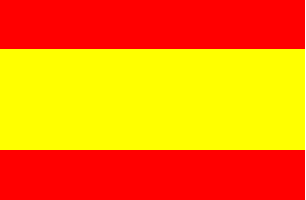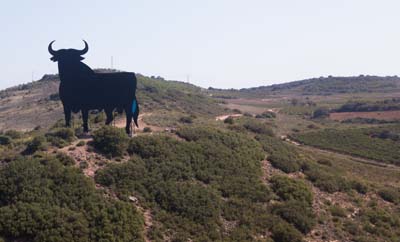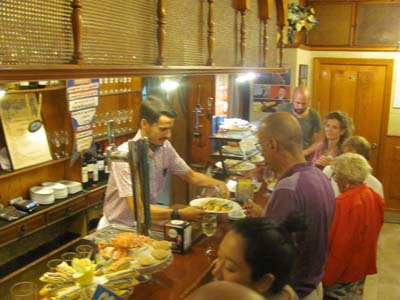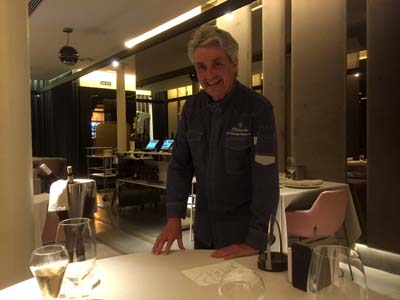
|
 |
part 3 |
Zaterdag 15 September 2018
An important reason for our stay in Lerma is the proximity to Burgos with its beautiful cathedral. It is about a half hour's drive to Burgos on the A1. We can park the car in a underground car park right in front of the city gate. After a cup of coffee on a terrace in the sun - in the shade it's pretty cool early in the morning - it's time for the Cathedral. For an entrance ticket to the Cathedral, we first have to enter the visitor center, which is located under the church. There are also lockers, where we have to leAfter our visit to the cathedral w
We want to go to the monastery de las Huelgas after lunch, but that is closed due to the siesta. That is why we return to Lerma. We look at the Vuelta in our room.
In the evening we eat a delicious dinner in the Parador.
Weather: in the afternoon to 30 degrees (86F)
Sunday 16 September 2018
Lerma - Logroño: 184km / 3:04 uur
We drink coffee in Lerma first and then drive on to Logroño, the
capital of the Rioja region. There is the big festival going on. The
festival of
San Mateo, which marks the beginning of the wine harvest. Actually too
early, because the harvest only starts in a few weeks. The whole city
and region have converged on Logrono. Bands walk through the streets,
everywhere there are drinks and food stalls on every square is a stage
for performances. The important streets are a big procession of visitors
and the terraces are full. It is also very noisy. We are staying in the
trendy boutique hotel Marques
de Vallejo, in the middle of the old town. We can drive in front
to unload the suitcases. Then we can park at a discount in a parking in
the newer part of the center on the other side of Paseo del Espelon.
We visit the concatedral, where mass is celebrated. Beautiful church,
but no comparison with those in Burgos. During the service, the party
noise penetrates into the church and the priests sermon completely
drowns out when the door opens. We return to the hotel. Then we eat some
tapas.
In the afternoon we walk to what remains of the city walls. Small part
of it can be visited. An artillery tower from the 16th century. At 6.30
pm we will eat tapas at Pasion
por ti in the busy street Calle
Laurel. A small and happening joint where they serve delicious and
beautifully made up tapas or pinchos. We choose some delicious tapas and
drink a nice wine with it.
weather: 30 degrees with sun
Monday 17 September 2018
After breakfast we drive to Haro, about 50 km north of Logroño and the
center of the
wine production of the Rioja region. We are going to visit the winery Muga.
We get a 1.5-hour guided tour through this traditional family business,
which produces an extensive collection of quality wines. 900,000 bottles
of crianza per year are bottled here. Of the Torre Muga, a signature
wine, only 4,000 in a year that the harvest is good enough. The lastest
one to have come on the market was 2010. The next one is from 2015. The
Crianza - the entry-level wine - is allowed to mature here for 3 years,
where most wineries use 2 years old wine. In fact, this crianza is a
Reserva. We are guided through all stages of the production p
 rocess,
making a distinction between the different wines that they make here.
From young white wines, to Cava and the top wines, which have to mature
for 5 years. Muga only works with oak barrels, which they make from
French oak. They only use new vessels. The used barrels are sold (to
whiskey distilleries). Their master cooper is already getting on in his
age and now he is training his son as a successor, just like he also
succeeded his father at the time. All tradition ...
rocess,
making a distinction between the different wines that they make here.
From young white wines, to Cava and the top wines, which have to mature
for 5 years. Muga only works with oak barrels, which they make from
French oak. They only use new vessels. The used barrels are sold (to
whiskey distilleries). Their master cooper is already getting on in his
age and now he is training his son as a successor, just like he also
succeeded his father at the time. All tradition ...
After the tour we get a sample of the white wine and of the crianza.
Back in Logroño we wash the car in a car wash. Then we have lunch in a
tapas bar. Around five o'clock we go outside for a coffee and a
cocktail. Around 9pm we eat at La
Iruña. A good restaurant with regional dishes. I take the tuna
salad, followed by a beef entrecote.
Weather: sunny, around 28 degrees in the afternoon. In the evening
heavy thunderstorms, but later dry again
Tuesday 18 September 2018
After breakfast and coffee in a café on the Paseo del Espolón we go to San Sebastian. We take the highway to Pamplona. In the outskirts of Pamplona there is a remarkable connection to the motorway to San Sebast
We have a break and have lunch in the form of some pintxos on Puerto street at Meson Portales. It is a kind of self-service. You pick up a plate and put as many pintxos as you want. Then you pay up. They taste reasonably well. In the afternoon we go to the beach, the Playa de Concha, which is located in the middle of the city. The beach is located in the bay of San Sebastian and is very flat. In the middle of the bay is a pontoon, from which boys show off their diving skills. After swimming we drink a beer on a terrace.
At six o'clock we are picked up by Iker Bardaji, our guide for the pintxos tour through the old city of San Sebastian. Iker talks a lot about the history of the city since the Romans, through the kingdom of Navarre, to the Napoleonic occupation. The English expelled the French in 1813, but destroyed the city by setting it on fire. Except for one street, where they wanted to house their soldiers. That street is now
We walk further into the newer city and see the modern Kursaal - a concert hall from 1999 -, the n
Weather: morning cloudy and cool. In the afternoon it gets warmer to 24 °
Wednesday 19 September 2018
We have a delicious breakfAt 4 pm we visit the Basilica de Santa Maria. The church was spared in the devastation of 1813, but it only became a basilica in 1973 after a papal visit in 1966. The interior of the church is nice with an altarpiece with a painting from the 19th century that represents Saint Sebastian (young man, pierced with arrows). Sebastian was an army officer under Emperor Diocletian, who was put on trial because of his Christian faith. In the back of the church there is another museum with ecclesiastical art.
We take another Dbizzi bike for a trip around the Urgull Mendia, the rocky peninsula, on which once a fortress stood. Now a large statue of Mary towers over the city. We cycle along the base of the rock and then drive over the river Urumea to the Kursaal in the Gros district. This auditorium
 was
completed in 1999 on the spot where a casino stood until 1924, when
gambling was banned under the rule of dictator Prima de Rivera. The old
Kursaal was demolished in 1972 and the lot was empty for more than 20
years. The architect Rafael Monea won the competition with his design,
which is reminiscent of two large basalt blocks that are used here as
breakwaters in the estuary.
was
completed in 1999 on the spot where a casino stood until 1924, when
gambling was banned under the rule of dictator Prima de Rivera. The old
Kursaal was demolished in 1972 and the lot was empty for more than 20
years. The architect Rafael Monea won the competition with his design,
which is reminiscent of two large basalt blocks that are used here as
breakwaters in the estuary.In front of the Kursaal is the Zurriola beach. In contrast to the Playa de Concha, it is not sheltered by a peninsula and therefore popular with the surfers riding the high waves.
We drink a cocktail at Dioni's gay bar and later in the evening we visit a number of pintxos bar: Txepetxa (specialized in many variations on Achovis), Zeruko (somewhat pretentious modern tapas), A fuego Negro (modern and innovative and fusion, but pleasant) and finally La Viña (famous for the cheesecake). To round it of we have a nightcap at Bar Martinez.
Weather: light to cloudy with sunny periods. 24 degrees
Thursday 20 September 2018
San Sebastian - Gernika - Bilbao: 216km 2:06 hrs
We have breakfast at Maiatza again and then go back to the pension to pack and leave. Receptionist Aitor is also back at his post (yesterday we were without reception) and gives us the bill. On the way to the car we drink coffee on the boulevard. Then we drive out of city on the motorway towards Bilbao. At Gernika we turn off the motorway and drive to this town with its eventful past. In 1937 the city was destroyed by German and Italian bombers in a support of General Franco's rebellion against the republican government. It did not serve any military purpose. It was primarily an exercise for the German Luftwaffe, which had been built up under Hitler in preparation for the Second World War. In that sense, Gernika was a rehearsal for Rotterdam. In Gernika we visit the Peace Museum. Impressive is the living room, where the story of the day is told from the perspective of a hoFurthermore, much attention is paid to the concept of peace and achieving it in many places around the world, such as in Northern Ireland, South Africa and Guatemala.
After the museum we walk to the Batzarretxea. In this building the representatives of the villages of the Basque Country had been meeting for centuries until 1879. First under a tree, later in a parliament building. The stump of the tree is still there, under a roof. Kings who ruled the Basque country confirmed the autonomy of the Basque Country under this tree. The Provincial Council of Bizkaia has been meeting here since 1979. Everything is strictly guarded by the Basque police. We drink something and eat a pintxo before we drive to the coast. The mouth of the Mundakako Itsasadarra river forms a beautiful estuary here. We drive along the coast past Bermio and Bakio.
Then on to Bilbao. Our apartment is in the old city, behind the San Nicolas Church
In the afternoon we go up the mountain with the funicular to enjoy the view of the city. We take the street car to get to the base staton. A very modern and new line. The cars still smell new. From the tram stop we cross the footbridge Zubizuri, designed by architect Calatrava. From the mountain Artxanda we see of course the Guggenheim Museum and also the stadium of Atletic de Bilbao.
Back in the old town we drink something on a terrace. In the evening we eat dinner at the Plaza Berri or Plaza Nueva (at La Olla) and we take a nightcap at the Bizitza gay bar.
Weather: sunny 28 degrees
Friday 21 September 2018
We have breakfast at cafe Bizuete. Busy, but quick, an reasonably good. We
take the tram to the Guggenheim
Museum Bilbao. The buildinWe take the metro back
 to
our apartment. In the afternoon I take a look at the covered market. This
was restored and rebuilt in 1983, after a major flood. Unfortunately, the
market is closed in the afternoon.
to
our apartment. In the afternoon I take a look at the covered market. This
was restored and rebuilt in 1983, after a major flood. Unfortunately, the
market is closed in the afternoon.In the evening we eat at the michelin star restaurant Etxanobe in the Esanche district in the new center. In the Atelier of chef Fernando Canales we have a 14-course menu with wine pairing. It is wonderful, spectacular and very well cooked. Some courses are prepared by Canales at our table. Erik may even assist with one dish. This star restaurant does not stand alone. Basque Country and Bilbao and San Sebastian in particular count many very good restaurants with stars in the Michelin Guide. It was a worthy conclusion to our journey through northwestern Spain.
Weather: sunny, 25 degrees
Saturday 22 September 2018
We get up early around 7 o'clock, after a rather difficult night. The
room was far too hot, but the window could not be opened because it was
too noisy outside with sounds of nightlife. Breakfast is hard to find,
because everything is still closed, except for a café, which is still
full of night owls, who are still pretty drunk. A coffee with a
sandwich, is the maximum we can get here. We then drive to the airport
of Bilbao, from where we leave with KLM at 11.50 am to Amsterdam. We
arrive there on time at 14.00. We have to wait a while for the luggage.
The Intercity Direct train service brings us in 27 minutes to Rotterdam
Central, where an Uber taxi is waiting for us. It's raining in
Rotterdam, but it's good to be at home again.
| |
Other Travel | |
| back |